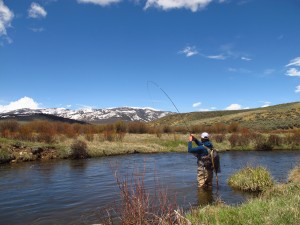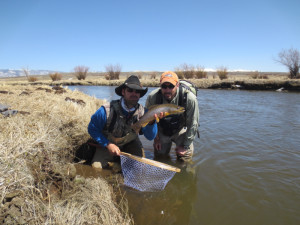Pre Run-Off Fishing in North Park
Every spring anglers get the itch to start fishing and it’s generally an itch that cannot be fully scratched until you catch a few trout, then it’s an itch that doesn’t go away until winter. No matter what the weather brings, just a few days of sun “kicks in” our fish senses and the urge to put the waders on and string a rod. Here in North Park it’s amazing these fish survive the brutal winters and suddenly switch from lying dormant to actively feeding. As anglers it’s fascinating to fish a freshly thawed river that’s temped at 32 to 38 degrees and have success. Usually finding open water is just a good excuse to put the gear on and cast a rod but to catch a few fish, well that’s a bonus. The simple truth is, here in North Park our river’s produce much like lakes do at ice off, and the pre-run off fishing can be every bit as good as our prime time fishing season
Conditions
River Ice Off
On a trip out to explore the park and throw some line, our conversation about where to fish tends to encompass what’s recently opened. More times than not, if you catch a river only a few days after ice off, you have a great opportunity to not only fish to trout which have not seen a fly yet, but to hone in on some of the larger fish who have to feed aggressively and more often. Yes, the river’s will tend to fish better as they warm and the early season progresses, but keep in mind, these fish have not seen daylight in 4 months and are generally pretty damn hungry right out of the gates. Along with catching the river’s as they ice off, it is also key to keep an eye on the one’s which have been open the longest. Fish are explorers and survivalists, and as temps rise in one tributary so will the fish count. For instance, if a particular tributary to the North Platte has been open for a few weeks and the North Platte itself is still frozen, we find that fish will navigate according to their senses up these tributaries to join resident fish for early spring feeding. Some of which can be very large and aggressive feeders looking for smaller fish as a meal.
As Temperature’s Rise
After initial ice off of the parks rivers we’ll start to see our first push in flows to the streams from the valley melt. In North Park we generally experience two runoff periods, the first being the subtle valley melt, and the second being the big push in water from the melt up high. The window between melts (Valley and High Country) is one of our favorite times of the year to be on the water. This is a time when the fish have everything going for them. By this time they have already been exposed to open water for a while and have been aggressively feeding. As the rivers and air temps slowly start to rise the fish kick into another gear and truly start to fatten up. With increased flows from the melting snow fish are awarded with a trough of food. Increased flows will scrub the river bottoms and chisel away at the banks exposing and washing food items downstream. Fish take advantage of this by sticking their nose in the heads of riffles and pools and wait for the food to come to them. It is also a great time for the bigger more elusive fish to explore the river in search of food. With a slight rise in water levels these larger fish feel more protected because there is simply more places to hide along the banks and in the structure, a perfect ambush spot. Along with the fish feeding well and getting comfortable in the streams, the snow will continue to dwindle on the valley floor. This means the water temperatures will also see a significant rise because there is not as much cold melt entering the system. This window right after valley runoff and before high mountain runoff can also be some of the best fishing the park has to offer.
Tips and Tactics
In the early season there are definitely some tips and tactics we use to search out and find where the fish will be feeding after a long winter. With the ice just coming off of the rivers it is more of an explorative trip out than catching lots of fish. There are fish to be caught, but finding they’re wintering holes is key. Low water temps along with the occasional snowy winter day will generally keep the fish holding in the deeper slack pools and runs. Our first trips out are mostly spent moving through water quickly and keying in on these deeper runs with streamers. A good rule of thumb is to make just a few casts and move on, if there is one in there, more than likely he’s hungry and will chase on the first or second cast. If you are fishing on an unseasonably warm sunny day, look for fish to move out of the deeper pools and position themselves just above. Here the sun can penetrate the shallow water and warm the rocks and the fish as well. As the early season progresses and we start to see our initial valley runoff, look for fish to really start spreading out and claiming their own spots. Now is the time to slow down a little more and pick the water apart. Fish can be located almost anywhere when they feel protected. From deep pools to riffles, and big log jams to beaver dams, these are all prime lies during this period. When this happens it’s also time to get out the bug box. Because of a push in flows, bugs will be dis-lodged from the rocks and banks and will become readily available to the fish. Stoneflies, aquatic worms, baetis nymphs, and midges are all good choices.
This is how we typically approach pre-run off every year, and every year is different. If you follow the advice given above and approach the water with patience and effort, you will be rewarded. Please feel free to stop by the shop and we would be happy to help you with anything you need. We realize people drive a long ways to get here and we want people to experience the beauty and solitude of this area as much as we do, and we want you to catch fish while you’re here of course.
Tight Lines, NPA Guide Tim Drummond






